Heading out on a road trip in your trusty pop-up camper is always an adventure. With the wind in your hair and the open road stretching out before you, there’s nothing quite like the freedom of hitting the highway with your cozy home on wheels. But before you embark on your journey, there’s one crucial detail you need to get just right: tire pressure. Yes, you heard it right – tire pressure. Now, you might be thinking, “How can something as mundane as tire pressure be so important?” Well, the tire pressure of your pop-up camper can make all the difference between a smooth and enjoyable ride and a bumpy, nerve-wracking experience that leaves you longing for the comfort of your stationary abode. So, buckle up and get ready to discover the tire pressure secrets that will take your pop-up camper adventures to another level.
Table of Contents
What is the Ideal Pop-Up Camper Tire Pressure?
Small Sized Campers
For smaller campers, such as pop-up campers and tent trailers, maintaining the ideal tire pressure is crucial. It is recommended to keep the tire pressure between 30 and 35 PSI to ensure a comfortable ride for both short and long trips. Regularly checking the tire pressure every few months is important to ensure they are inflated to a safe level. This will not only enhance the camper’s performance but also contribute to a smoother and more enjoyable camping experience.
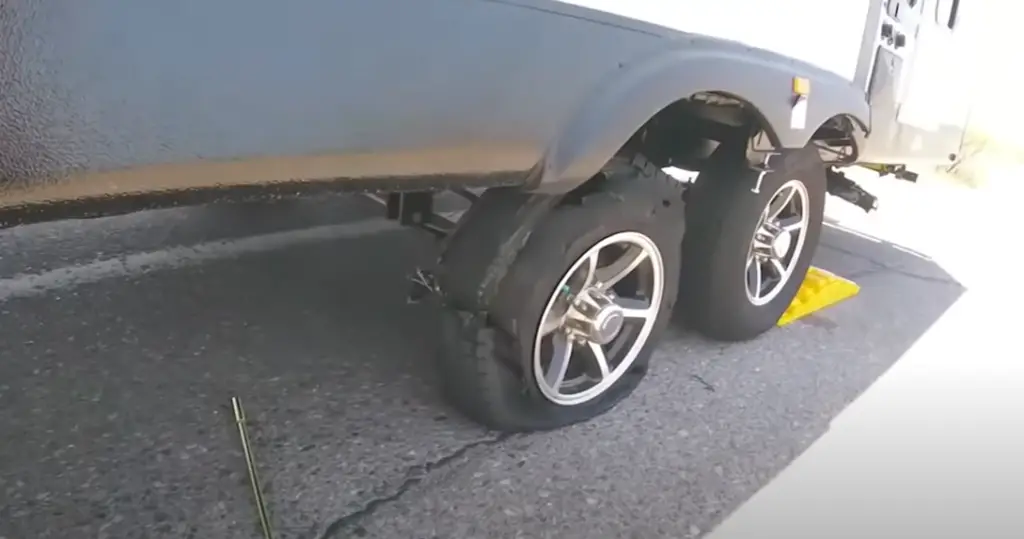
Medium-Sized Campers
Medium-sized campers, such as travel trailers and fifth-wheels, typically require higher tire pressures of between 30 and 60 PSI. It is important to check the manufacturer’s instructions to confirm the optimal pressure for your particular camper. While it may be tempting to set the tires at a lower pressure to gain better fuel economy, doing so can lead to a bumpier ride and even blowouts. It is also important to check the tire pressure whenever your camper’s weight has changed, such as when loading it with extra camping gear or supplies.
Large Sized Campers
For larger campers, such as motorhomes and Class A coaches, the recommended tire pressure is between 65 and 95 PSI. It is important to keep the tires inflated at a higher pressure to account for the added weight of these campers. As with other sizes, it is essential to follow your manufacturer’s instructions and regularly check the tire pressure before any long trips or when loading up your camper with extra gear or supplies. Keeping an eye on your wheels and making sure they have the ideal tire pressure can help make your camping experience more enjoyable [1].
What Does Pop-up Camper Tire Pressure Depend on?
Weight of the Camper
The most obvious factor that affects the tire pressure of your pop-up camper is its weight. Generally speaking, heavier campers will require a higher air pressure than lighter campers, as they put more strain on the tires. When checking and adjusting your tire pressure, make sure you take into account how much cargo you’re carrying in your camper.
In addition to weight, another factor that can influence tire pressure is the type of terrain you’ll be traversing. If you’re planning to venture off-road or encounter rough terrain, it’s advisable to slightly increase the tire pressure to ensure better stability and reduce the risk of punctures. On the other hand, if you’ll be primarily driving on smooth highways, a slightly lower tire pressure can provide a more comfortable ride.
Remember, proper tire pressure not only ensures optimal performance and fuel efficiency but also contributes to the overall safety of your pop-up camper. So, take the time to regularly check and adjust the tire pressure based on your camper’s weight, cargo, and the type of terrain you’ll be exploring.
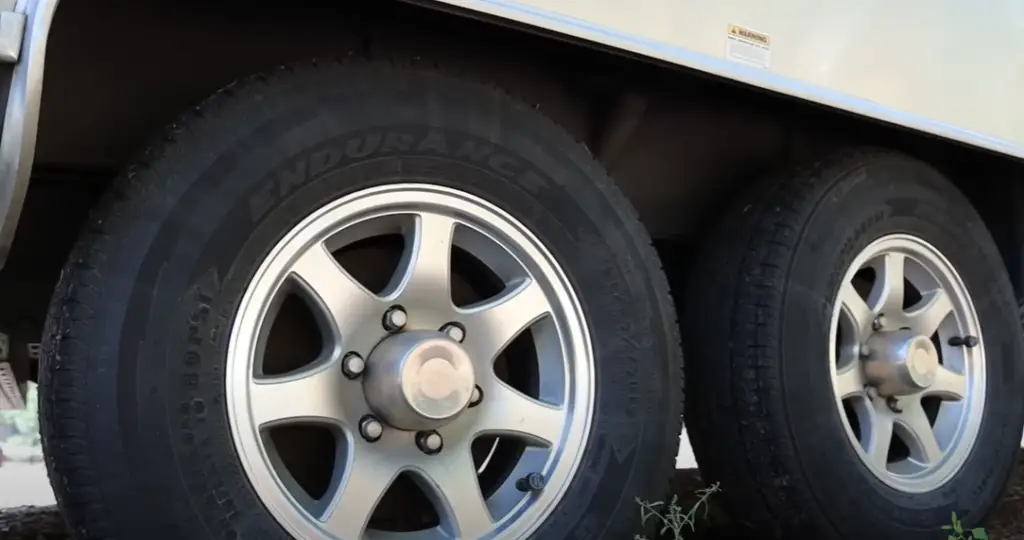
Weather Conditions
The weather can have a significant impact on the condition of your tires. When cooler temperatures are anticipated, it is advisable to add a few pounds of pressure to the tires to prevent them from going flat. This is because cold weather causes the air inside the tires to contract, potentially leading to underinflation. Conversely, during warm temperatures, the air inside the tires expands, which means you need to exercise caution and avoid overinflating your tires in hot weather to prevent any potential damage.
Road Conditions
It is also important to take the condition of the roads into account when setting your tire pressure. If you’ll be driving on gravel or dirt roads, a slight increase in air pressure can help minimize wear and tear on the tires as well as reduce the risk of punctures. On the other hand, if you are driving predominantly on paved roads, slightly lower tire pressure can make for a smoother ride.
Load Bearing Capacity
The load-bearing capacity of your camper tires should always be taken into consideration when setting the tire pressure. Overinflating your tires can put excessive strain on them and lead to premature wear and tear. On the other hand, underinflation will reduce their lifespan as well as cause poorer stability and handling.
Tire Condition
Finally, the condition of your tires is a critical factor that can affect the tire pressure. If you notice any wear or damage to your camper’s tires, it’s important to replace them with new ones as soon as possible. This will reduce the risk of blowouts and ensure optimal performance and safety while driving.
Finding the Right Tire Pressure
Pressure Label
Most tires have a pressure label that will tell you the minimum and maximum air pressure for the tire. It is located on either the sidewall or around the rim of the tire. This information will help you make sure you don’t exceed the recommended psi for your tires. Be sure to read this label carefully, and if you are unsure, consult with a professional mechanic. On the label can be written the symbol for psi, which stands for pounds per square inch. For example, a label with a psi of 35-45 means that your tire should have a minimum pressure of 35 and a maximum pressure of 45.
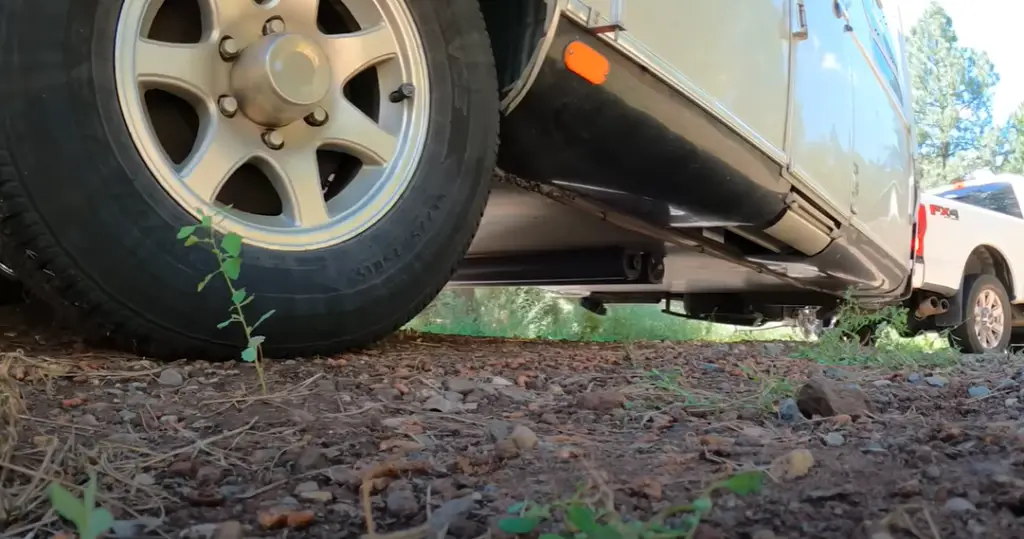
Tire Sidewall
The sidewall of your tire is also important when it comes to finding the right tire pressure. Generally speaking, you want to aim for a tire pressure that is within 10% of the manufacturer’s recommended psi. For example, if the recommended psi for your tire is 35-45, then aim for a pressure range between 31.5 and 40.5. The difference between the minimum and maximum psi should never be too large, as this can cause excessive wear on your tires.
Temperature Considerations
Another important factor to consider when finding the right tire pressure is temperature. As temperatures increase or decrease, so does tire pressure; therefore, you want to make sure that you check your tires regularly and adjust the pressure accordingly. Colder temperatures tend to cause a decrease in tire pressure, while hotter temperatures can cause an increase. You should also be aware that when you drive, your tires will heat up and the air inside your tires will expand. Keep this in mind and make sure to check your tire pressure regularly especially if you have been on longer drives or during periods of extreme hot or cold.
Manufacturer’s Manual
Finally, it’s always a good idea to consult the manufacturer’s manual before making any adjustments to your tires. The manual will provide more specific information about the recommended tire pressure for your vehicle and should be considered as the final authority on how to best maintain your tires. Following these guidelines can help ensure that your tires last longer and perform better [2].
How to Choose Tires for Pop-Up Campers and Trailers?
When choosing tires for your pop-up camper or trailer, there are a few factors to consider. The durability of the tire, size and load rating are all important things to consider when selecting the right tire for your needs. Additionally, it’s important to make sure that the tire pressure is correct before you hit the road.
When it comes to the tire pressure, it should be set to the manufacturer’s recommended pressure. This may include a higher inflation for heavier trailers and pop-up campers. It is important to check the tire pressure when you begin your journey and again every few hours or so as you travel on the road. Doing this helps ensure that you have enough traction and proper weight distribution throughout your trip.
Pop-Up Camper Tire Safety Tips
Tires are one of the most important components of a pop-up camper. The proper air pressure allows for optimal performance and handling. It is essential to check tire pressure regularly, as under-inflation can reduce your fuel economy, cause the tires to wear out faster, and even lead to an accident.
Here are some tips to help you keep your tires in good condition:
- Check the recommended tire pressure before you hit the road. It is usually printed on the side of each tire or can be found in your vehicle’s manual.
- Keep a tire pressure gauge handy and check your tires regularly at least once a month, especially if you frequently drive on rough terrain or live in an area that experiences extreme temperatures.
- When checking the tire pressure, make sure to add air if the recommended PSI is not met.
- If you’re planning a long drive, bring along a portable air compressor so you can easily top up the tires as needed.
- Make sure to use the correct type of air for your pop-up camper. If you’re not sure what type of air to use, refer to your vehicle’s manual or consult with a professional mechanic.
- Don’t forget to check the tread depth of your tires as well, as this will affect their traction and performance on the road.
- Always use the best quality tires you can find for your pop-up camper – this will ensure maximum safety and performance.
- Don’t forget to inspect your spare tire before each trip, as this could save you from a potentially dangerous situation on the road.
- Finally, always make sure that any additional loads or luggage are properly secured within your pop-up camper. Excessive loads placed on the tires can lead to an accident.
By following these tips, you can ensure that your pop-up camper is always safe and road-ready! Be sure to stay aware of the tire pressure levels, as this will help maintain maximum performance and safety while on the road.
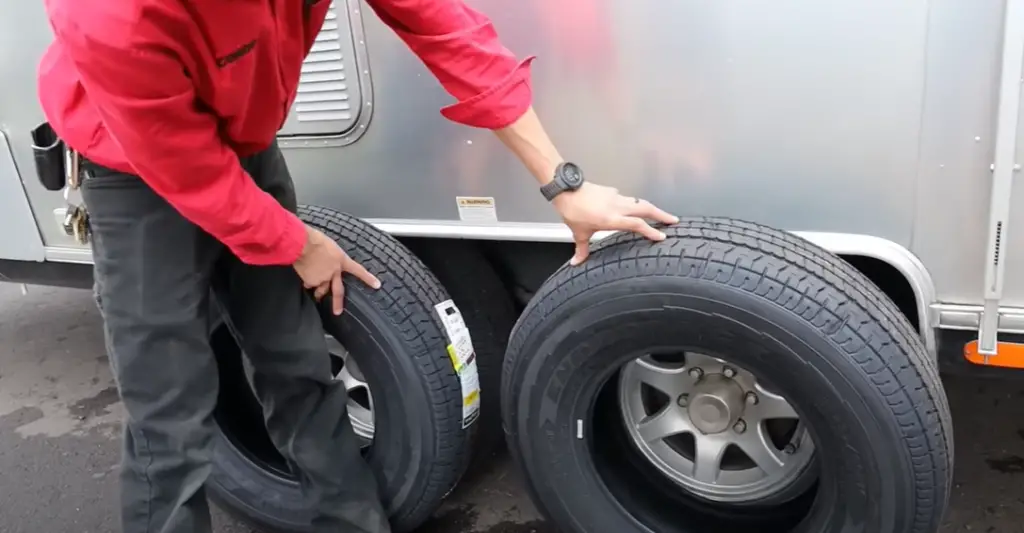
FAQ
What psi should trailer tires be set at?
Tire pressure for trailer tires should generally be set to the maximum air pressure printed on the tire’s sidewall. This is because when a load is placed in a trailer, it can cause the tire to flex and lose pressure. Having the tires at their maximum psi reduces this risk, making them more reliable and safe. It is important to check your tire pressures regularly, as underinflation can lead to poor handling and a decrease in fuel efficiency. Additionally, it is important to check your tow vehicle’s owner’s manual for the correct psi for their specific tires.
What temperature do I inflate my trailer tires?
Trailer tire pressure should be adjusted according to the outside air temperature at the time of inflation. The tire’s specified maximum air pressure should be adjusted according to the charts found in your owner’s manual or on the sidewall of the tire itself. For example, if a tire has a maximum inflation of 80 psi and it is 50°F outside, then you would adjust the pressure to 76 psi for optimal performance. This ensures that your tires will remain at their proper pressure regardless of the temperature, as tire pressure can increase or decrease with changes in air temperature.
What are the consequences of underinflated trailer tires?
Underinflated trailer tires can have serious consequences – they may cause your vehicle to handle poorly and be less fuel efficient; they can also put additional stress on other components, such as the bearings and suspension system. Furthermore, underinflated tires are more prone to punctures and blowouts due to excessive flexing of the sidewall. In extreme cases, an underinflated tire can even burst while driving, resulting in a loss of control over your vehicle. For these reasons, it is important to check your trailer’s tire pressure regularly and adjust it as needed.
What is the air pressure for 10 ply trailer tires?
The maximum air pressure for 10-ply trailer tires depends on the manufacturer’s specifications, which can be found in the owner’s manual or on the sidewall of the tire. Generally speaking, it is recommended to set 10-ply trailer tires to their specified maximum air pressure, with occasional adjustments being made for changes in outside temperature. As always, it is important to double-check the owner’s manual or tire sidewall for specific details.
Are trailer tires different than car tires?
Yes, trailer tires are different from car tires in many ways. They typically have a higher load capacity and maximum air pressure than car tires, as well as a harder rubber compound to help resist wear and tear from frequent use. Additionally, trailer tires are designed to be more resistant to punctures and have a thicker tread pattern for improved traction. These features make them better suited for the constant stop-and-go action of trailer applications, as well as the increased load capacity required from trailers.
What is the best way to store trailer tires?
The best way to store trailer tires is to keep them in a cool, dry place away from direct sunlight and temperatures above 70°F. It is also important to inspect your tires regularly for signs of wear or damage, such as cracks, bald spots, bulges, or punctures. Additionally, make sure the tires are inflated to their proper air pressure before storing them for extended periods.
Useful Video: Camper Tire Pressure – Novice to Expert
Conclusion Paragraph
Tire pressure in a pop-up camper can be a tricky thing to manage. If your tires are not inflated properly, it can cause significant damage and even lead to an unsafe situation. It’s important to know the correct tire pressure for your particular model so that you can ensure that your pop-up camper is in good condition and safe for use. For more information on how to check and adjust the pressure of your camper tires, feel free to consult the manual that came with your camper or reach out to an expert for help. Taking good care of your pop-up camper’s tires is essential for ensuring a safe and enjoyable camping experience.
References:
- https://www.rvcampgear.com/what-should-pop-up-camper-tire-pressure-be/
- https://www.allstate.com/resources/car-insurance/when-and-how-to-check-tire-pressure

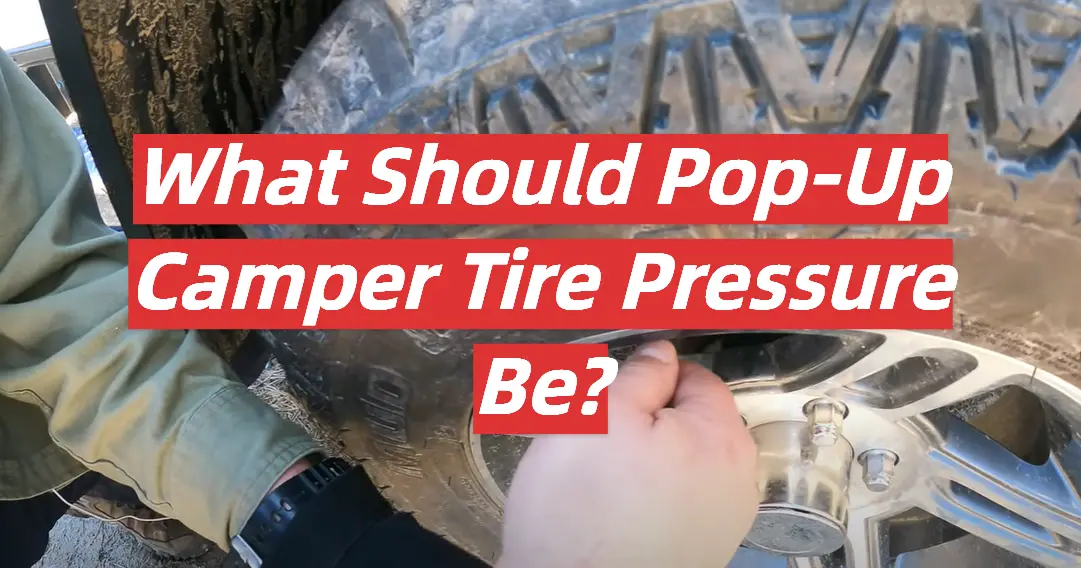
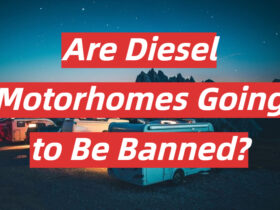
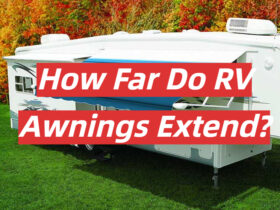
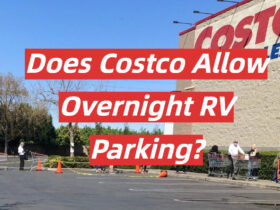
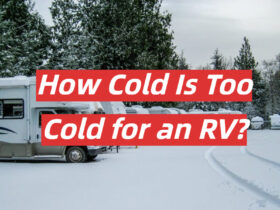
Leave a Reply